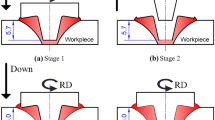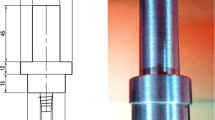Abstract
Fully coupled thermo-mechanical model is used to obtain the true strain components. The sizes of the TMAZ and the SZ are predicted according to the different behaviors of the traced material particles. The strain rate and the temperature histories are used to calculate the Zener-Hollomon parameter and then the grain size in the SZ. Results indicate that the contribution from the temperatures is much more important than the one from the deformations. The strain rates at the advancing side are higher than the ones at the retreating side on the top surface but become symmetrical on the bottom surface. The widths of the TMAZ and the SZ become narrower in smaller shoulder diameter. Smaller shoulder can lead to smaller grain size in the SZ.
Similar content being viewed by others
References
R. Nandan, G. G. Roy, T. J. Lienert and T. Debroy, Threedimensional heat and material flow during friction stir welding, Acta Mater., 55 (2007) 883–895.
K. Colligan and R. S. Mishra, A conceptual model for the process variables related to heat generation in friction stir welding of aluminum, Scripta Mater., 58 (2008) 327–331.
G. Q. Chen, Q. Y. Shi, Y. J. Li, Y. J. Sun, Q. L. Dai, J. Y. Jia, Y. C. Zhu and J. J. Wu, Computational fluid dynamics studies on heat generation during friction stir welding of aluminum alloy, Comput. Mater. Sci., 79 (2003) 540–546.
S. W. Kang, B. S. Jang and J. W. Kim, A study on heat-flow analysis of friction stir welding on a rotation affected zone, J. Mech. Sci. Technol., 28 (9) (2014) 3873–3883.
M. Abbasi, B. Bagheri and R. Keivani, Thermal analysis of friction stir welding process and investigation into affective parameters using simulation, J. Mech. Sci. Technol., 29 (2) (2015) 861–866.
A. Arora, R. Nandan, A. P. Reynolds and T. DebRoy, Torque, power requirement and stir zone geometry in friction stir welding through modeling and experiments, Scripta Mater., 60 (2009) 13–16.
Z. Zhang and H. W. Zhang, Numerical studies on controlling of process parameters in friction stir welding, J. Mater. Process. Technol., 209 (2009) 241–270.
J. W. Pew, T. W. Nelson and C. D. Sorensen, Torque based weld power model for friction stir welding, Sci. Technol. Weld. Joi., 12 (2007) 341–347.
Z. Zhang and H. W. Zhang, A fully coupled thermomechanical model of friction stir welding, Int. J. Adv. Manuf. Technol., 37 (2008) 279–293.
H. W. Nassar and M. K. Khraisheh, Simulation of material flow and heat evolution in friction stir processing incorporating melting, J. Eng. Mater. Technol., 134 (4) (2012) 041006.
S. Tutunchilar, M. Haghpanahi, M. K. B. Givi, P. Asadi and P. Bahemmat, Simulation of material flow in friction stir processing of a cast Al-Si alloy, Mater. Des., 40 (2012) 415–426.
A. De and T. DebRoy, A perspective on residual stresses in welding, Sci. Technol. Weld. Joi., 16 (2011) 204–208.
P. Michaleris, Modelling welding residual stress and distortion: current and future research trends, Sci. Technol. Weld. Joi., 16 (2011) 363–368.
M. Riahi and H. Nazari, Analysis of transient temperature and residual thermal stresses in friction stir welding of aluminum alloy 6061-T6 via numerical simulation, Int. J. Adv. Manuf. Technol., 55 (2011) 143–152.
H. S. Mun and S. I. Seo, Welding strain analysis of friction stir-welded aluminum alloy structures using inherent strainbased equivalent loads, J. Mech. Sci. Technol., 27 (9) (2013) 2775–2782.
Z. Zhang and Z. Y. Wan, Predictions of tool forces in friction stir welding of AZ91 magnesium alloy, Sci. Technol. Weld. Joi., 17 (6) (2012) 495–500.
A. Arora, M. Mehta, A. De and T. DebRoy, Load bearing capacity of tool pin during friction stir welding, Int. J. Adv. Manuf. Technol., 61 (2012) 911–920.
L. Fratini and G. Buffa, CDRX modelling in friction stir welding of aluminium alloys, Int. J. Mach. Tool. Manuf., 45 (2005) 1188–1194.
A. Gerlich, M. Yamamoto and T. H. North, Strain rates and grain growth in Al 5754 and Al 6061 friction stir spot welds, Metall. Mater. Trans. A, 38 (2007) 1291–1302.
G. Buffa and L. Fratini, Friction stir welding of steel: process design through continuum based FEM model, Sci. Technol. Weld. Joi., 14 (2009) 239–246.
A. Bastier, M. H. Maitournam, K. D. Van, and F. Roger, Steady state thermomechanical modelling of friction stir welding, Sci. Technol. Weld. Joi., 11 (2006) 278–288.
H. Schmidt and J. Hattel, A local model for the thermomechanical conditions in friction stir welding, Model. Simul. Mater. Sci. Eng., 13 (2005) 77–93.
Z. Zhang and H. W. Zhang, Numerical studies of preheating time effect on temperature and material behaviors in friction stir welding process, Sci. Technol. Weld. Joi., 12 (5) (2007) 436–448.
Z. Zhang and J. T. Chen, Computational investigations on reliable finite element based thermo-mechanical coupled simulations of friction stir welding, Int. J. Adv. Manuf. Technol., 60 (2012) 959–975.
H. W. Zhang, Z. Zhang and J. T. Chen, The finite element simulation of the friction stir welding process, Mater. Sci. Eng. A, 403 (2005) 340–348.
A. Arora, Z. Zhang, A. De and T. DebRoy, Strains and strain rates during friction stir welding, Scripta Mater., 61 (2009) 863–866.
D. Kim, H. Badarinarayan, J. Kim, C. Kim, K. Okamoto, R. H. Wagoner and K. Chung, Numerical simulation of friction stir butt welding process for AA5083-H18 sheets, Euro. J. Mech. A/Solids, 29 (2010) 204–215.
Z. Zhang and J. T. Chen, The simulation of material behaviors in friction stir welding process by using rate-dependent constitutive model, J. Mater. Sci., 43 (2008) 222–232.
M. Grujicic, G. Arakere, B. Pandurangan, J. M. Ochterbeck, C. F. Yen, B. A. Cheeseman, A. P. Reynolds and M. A. Sutton, Computational analysis of material flow during friction stir welding of aa5059 aluminum alloys, J. Mater. Eng. Perform., 21 (9) (2012) 1824–1840.
Z. Zhang, Comparison of two contact models in the simulation of friction stir welding process, J. Mater. Sci., 43 (2008) 5867–5877.
Z. Zhang and H. W. Zhang, Numerical studies on the effect of transverse speed in friction stir welding, Mater. Des., 30 (2009) 900–907.
Z. Zhang and H. W. Zhang, Numerical studies on the effect of axial pressure in friction stir welding, Sci. Technol. Weld. Joi., 12 (3) (2007) 226–248.
H. W. Zhang, Z. Zhang and J. T. Chen, 3D modeling of material flow in friction stir welding under different process parameters, J. Mater. Process. Technol., 183 (2007) 62–70.
W. H. Van Geertruyden, W. Z. Misiolek and P. T. Wang, Grain structure evolution in a 6061 aluminum alloy during hot torsion, Mater. Sci. Eng. A, 419 (2006) 105–114.
Y. S. Sato, M. Urata and H. Kokawa, Parameters controlling microstructure and hardness during Friction-Stir welding of precipitation-hardenable aluminum alloy 6063, Metall. Mater. Trans. A, 33 (A) (2002) 625–635.
Author information
Authors and Affiliations
Corresponding author
Additional information
Recommended by Editor Chongdu Cho
Zhao Zhang, Ph.D., is a professor in Department of Engineering Mechanics at Dalian University of Technology. He received his doctoral degree from Dalian University of technology in 2007. He is a member of International Association of Computational Mechanics and serves as reviewers for about 20 international journals. His scientific research is focused on numerical simulation of friction stir welding, safety design of locomotive, and fracture mechanics. He published about 30 SCI indexed articles with about 320 citations.
Rights and permissions
About this article
Cite this article
Zhang, Z., Wu, Q. Numerical studies of tool diameter on strain rates, temperature rises and grain sizes in friction stir welding. J Mech Sci Technol 29, 4121–4128 (2015). https://doi.org/10.1007/s12206-015-0906-3
Received:
Revised:
Accepted:
Published:
Issue Date:
DOI: https://doi.org/10.1007/s12206-015-0906-3




